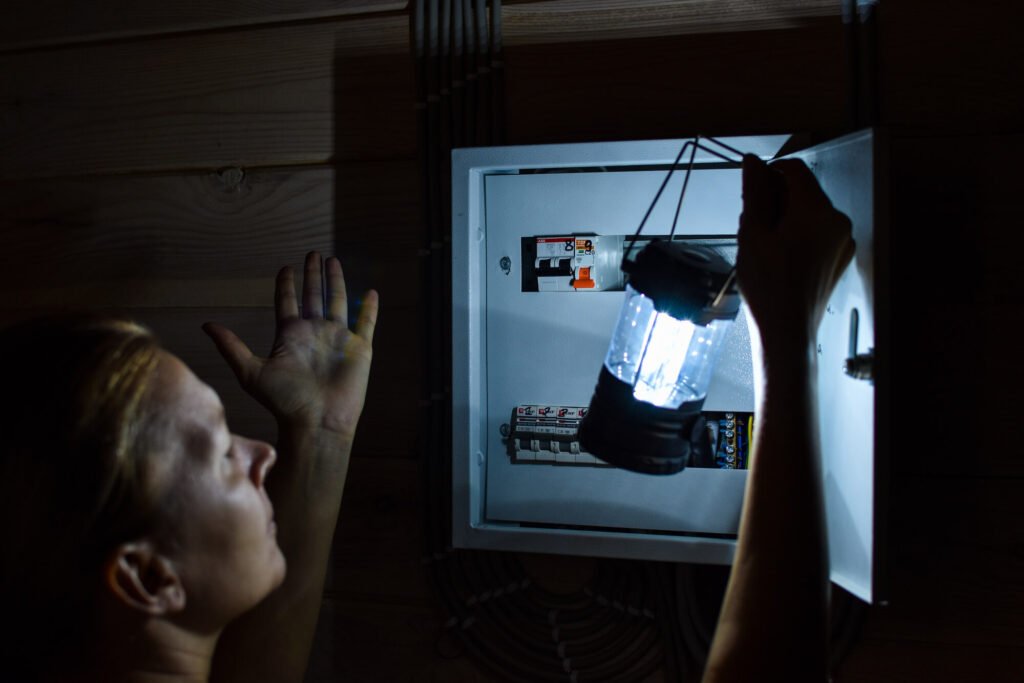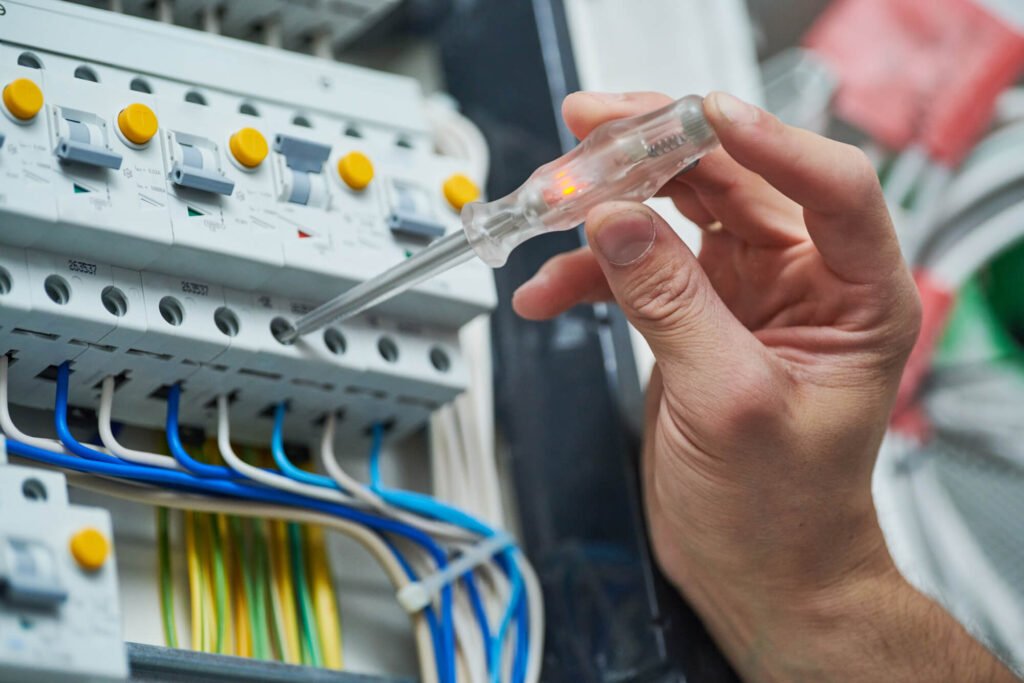

Power outages can strike at any moment, disrupting our daily routines and leaving us in the dark – literally. Whether you’re in the middle of cooking dinner, working from home, or simply relaxing with your family, an unexpected loss of electricity can be both inconvenient and unsettling. However, understanding the causes of power outages and how to respond effectively can make all the difference in minimising their impact on your home and daily life.
Causes of Power Outages
Understanding the varied causes behind power outages is paramount for homeowners to effectively prepare for and respond to these disruptions. Power outages can be brought on by several different reasons which can be categorised into both external and internal factors.
External Causes
- Weather-Related
Storms: severe thunderstorms can unleash powerful winds, torrential rains, and lightning strikes, wreaking havoc on infrastructure.
Lightning: capable of striking power lines, transformers, or substations, it can cause instantaneous damage and trigger widespread outages. The immense energy of a lightning bolt can even overload circuits and melt electrical components, rendering them inoperable.
High winds: gale-force winds pose a significant threat to power lines and utility poles. Wind-borne debris, such as branches, signage, and airborne objects, can also collide with overhead wires.
Heat waves: prolonged periods of extreme heat, commonplace in Australia, can strain electrical grids and equipment. Coupled with a heightened demand for air conditioning, heat waves can overwhelm supply capacity and necessitate load shedding measures.
- Severe Weather Events
Bushfires: wildfires can engulf power poles, transformers, and transmission lines, causing catastrophic damage and necessitating pre-emptive power shutdowns for public safety.
Earthquakes: seismic tremors and ground movements during earthquakes can rupture underground cables, fracture utility conduits, and damage electrical substations. Structural damage to power infrastructure can result in cascading failures and prolonged outages in affected areas.
Landslides: slope instability and soil erosion during heavy rainfall events can trigger landslides, posing a threat to overhead power lines and transmission towers, as well as burying access to electrical infrastructure.
- Utility Issues
Planned maintenance: scheduled maintenance and planned outages by utility providers may be necessary to facilitate maintenance activities such as equipment inspections, line repairs, and infrastructure upgrades.
Equipment malfunctions: despite rigorous maintenance regimes, utility equipment such as transformers, switches, and circuit breakers can experience unexpected failures due to manufacturing defects, material fatigue, or environmental stressors.
Distribution network issues: complex interdependencies within the power distribution network can amplify the impact of localised faults and disturbances. Voltage fluctuations, phase imbalances, and load mismatches can propagate across interconnected circuits, exacerbating outage conditions and affecting multiple service areas simultaneously.
- Accidents and Human Error
Car accidents: errant drivers, distracted driving, and inclement weather conditions contribute to the risk of vehicular accidents near electrical facilities.
Construction mishaps: construction activities near power corridors, roadways, or building sites carry inherent risks of inadvertent contact with overhead power lines, underground cables, or buried conduits. Excavation work, demolition activities, and equipment operations can inadvertently damage electrical infrastructure, leading to service disruptions.
Operator errors: human errors during routine maintenance, repair procedures, or operational tasks can compromise the integrity and functionality of power systems. Inadequate training, procedural lapses, and communication breakdowns contribute to the risk of operator errors and equipment failures.


Internal Causes
- On Your Property
Faulty wiring: aging, degraded, or improperly installed electrical wiring within residential properties can pose significant fire and safety hazards.
Appliance overload: the proliferation of electrical appliances, gadgets, and devices in modern households has led to increased demand for power outlets and circuits. Overloading electrical circuits with multiple appliances or high-wattage devices can exceed the rated capacity of wiring and protective devices, leading to overheating, tripped breakers, and electrical failures.
Defective appliances: malfunctioning or defective appliances with internal faults, damaged cords, or compromised insulation can pose serious risks to electrical safety.
- Equipment Failures
Tripped fuses: circuit protection devices such as fuses are designed to interrupt the flow of electricity in the event of overcurrent conditions or faults. Tripped fuses indicate potential issues such as short circuits, or ground faults.
Faulty circuit breakers: circuit breakers serve as crucial safeguards against electrical hazards by automatically disconnecting circuits in response to abnormal conditions. However, aging, mechanical wear, and improper settings can impair the reliability and performance of circuit breakers, leading to nuisance tripping and intermittent outages.
Utility company issues: problems within the utility’s infrastructure, including substation failures, transmission line faults, and grid disturbances, can affect the reliability and continuity of power supply to residential customers. Timely communication and coordination with utility providers are essential for diagnosing and resolving utility-related outages. You can check for blackouts by visiting the Ausgrid website here.
What To Do In The Event Of A Power Outage
- Assess the situation: determine whether the power outage is localised to your property or if neighbouring homes are also affected. Check streetlights and nearby buildings for signs of electricity.
- Report the outage: contact your local utility provider to report the outage and receive updates on restoration efforts. Utilities often provide outage reporting hotlines or online portals for convenience.
- Preserve food and medications: keep refrigerator and freezer doors closed to retain cold temperatures and prevent food spoilage.
- Use alternative lighting: utilise battery-powered lanterns, flashlights, or candles placed in secure holders to provide illumination during the outage.
- Stay informed: listen to battery-operated radios or access emergency updates via mobile devices for information on the outage’s duration, safety advisories, and restoration progress.
By adequately preparing for external causes of power outages, homeowners can take proactive steps to minimise damage to their property and the risk of inconvenience caused by a power outage. This includes trimming overhanging tree branches near power lines and securing outdoor items to prevent damage during severe weather. Additionally, maintaining an emergency kit with essential supplies like food, water, first aid, and batteries ensures readiness during outages. Investing in backup power sources like generators or solar devices can provide added support, but it’s vital to operate them safely. Familiarising oneself with community resources and emergency shelters further enhances preparedness, particularly during storms, as well as speaking to your neighbours and fostering resilience through community support networks.
When a power outage occurs, there are several steps you need to take to address problems within your own home. Identifying these issues can help expedite the restoration of power to your property:
- Check circuit breakers and fuses: inspect your home’s circuit breaker panel or fuse box to identify any tripped breakers or blown fuses. Reset tripped breakers by switching them to the “off” position and then back to “on.”
- Unplug appliances: unplug electronic devices and appliances to prevent damage from power surges when electricity is restored. Gradually reconnect appliances once power is stabilised to avoid overloading circuits.
- Inspect wiring and outlets: examine electrical outlets, switches, and wiring for signs of damage, overheating, or loose connections. Contact a professional electrician if you detect any abnormalities or suspect wiring issues.
- Test GFCI outlets: press the test and reset buttons on ground fault circuit interrupter (GFCI) outlets to verify proper functionality. GFCIs are designed to protect against electrical shocks and should be tested regularly, especially in areas prone to moisture such as kitchens, bathrooms, and outdoor locations.


So, When Exactly Should You Call An Electrician?
If you’re experiencing persistent or frequent power outages despite troubleshooting, it’s best to seek assistance from qualified local electricians. Safety is paramount, particularly if you notice sparking outlets, smoking fixtures, or unusual odours like burning plastic, in which case immediately evacuate the premises and contact emergency services. When reaching out to an electrician, it’s helpful to provide details such as the outage duration, observed symptoms (warning signs), and any recent electrical work or structural modifications to your home. This can facilitate a swift and accurate diagnosis of the underlying issue.
Moving Forward with Confidence
Proactive measures are the key to mitigating the impact of power outages on your home and daily life. Too many Australian homeowners are reactive and unaware of easy preventative measures.
Regular maintenance of electrical systems for one, including wiring, appliances, and circuit breakers, can help identify potential issues before they escalate into full-blown outages. Upgrading equipment, as well as investing in surge protectors, and implementing energy-efficient solutions are also effective strategies for reducing the risk of power disruptions. You could even consider diversifying from the grid by investing in a generator or solar panels.
And while power outages may be unavoidable at times, being proactive in understanding and preventing them can significantly minimise their impact. By staying informed and engaging with the community, maintaining emergency supplies, and investing in backup power options, homeowners can ensure the safety and well-being of their families. Let’s empower ourselves to take charge of our electrical systems and be proactive in safeguarding our homes against electrical emergencies.
For power outage solutions, trust our professional electrician services on the Central Coast to quickly and safely restore your power. Our team is equipped to handle any situation, ensuring your home is back to normal as soon as possible. If you’re in Newcastle and facing electrical issues, our expert Newcastle electrician services are ready to assist. We provide top-notch solutions to keep your home powered and secure. Contact us today to experience the difference with our reliable and skilled electrical services.
